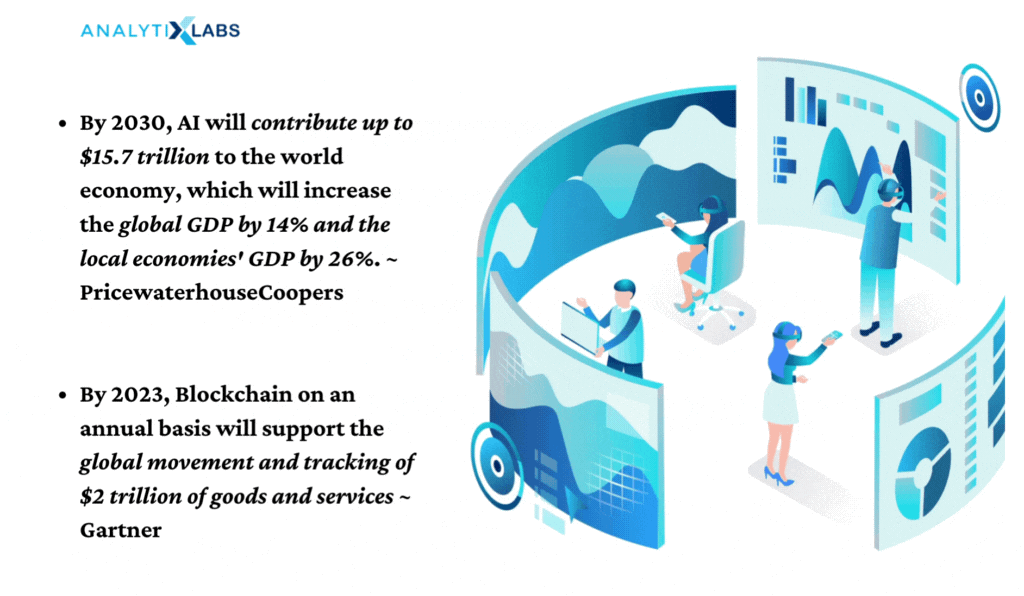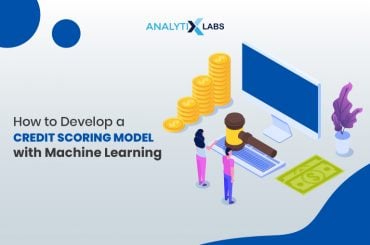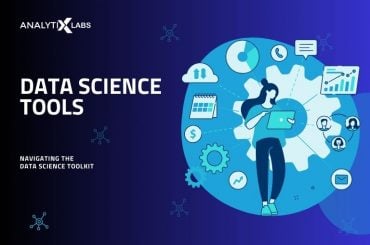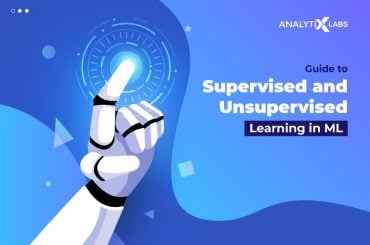Blockchain technology is the backbone of Bitcoin. While the most prominent and first real application of blockchain is Cryptocurrency, it is not limited to it. Cryptocurrency is just the tip of the iceberg when it comes to blockchain technology. There’s a lot more to it. Along with blockchain, another concept that is a rage is machine learning. And when you combine blockchain technology and machine learning, you simply tap into a gamut of possibilities for the tech world. Blockchain and machine learning together have the power to revolutionize the tech industry for good.
However, first things first.
What is Blockchain technology?
Blockchain is a type of Distributed Ledger Technology (DLT) and can digitally record transactions. The name itself is symbolic of its function: Block + Chain. The USP of blockchain technology is it makes it next to impossible to modify or hack the system.

Components of Blockchain
Blockchain has three major components:
- Blocks
- Nodes
- Miners
The entire blockchain system comprises of nodes that are transparent and connects to the distributed ledger, as shown below:

Blocks
Blocks are built in such a way that there is a certain storage capacity for it. Once the storage capacity of the block is filled, the data os stored in new blocks. These blocks are then linked or chained to the previous blocks. This way the data is structured into a linear and chronological chain of blocks.
When a block is generated, each block has two numbers making it unique. One is nonce, a 32-bit whole number that is generated randomly. This leads to the creation of the hash, a 256-bit number. Once the data or transaction is recorded in the block, the nonce is enabled which is the permanent number. The hash value, on the other hand, can be mined.
Nodes
Nodes are the type of electronic device which helps in maintaining the copies of the blockchain.
Miners
The validation process of each transaction is called mining. Miners secure the network and confirm every transaction.
Properties of Blockchain
- Decentralized and Distributed: The blockchain is not owned by a single computer or organization. Each participant has a copy of the blockchain. The system is a distributed ledger connected via the nodes and is transparent. Every time a new transaction happens, it is recorded and added to each of the participants’ ledger. Each participant has a unique alphanumeric identification number that shows their respective transactions.
- Secure: Each block has its own unique nonce and hash number. Along with this the blocks also have references to the hash and timestamp of the previous block. In case, any one value is misaligned, then cross-referencing with other values helps in the detection of the fraud making blockchain a secure system.
- Immutable: Each of the validated transactions in the blockchain is unalterable.
- Time-stamped: Each block when added to the chain is imprinted with an irreversible timestamp.
- Concordance: To change any data or information on the blockchain, requires the validation of the transactions (or the mining process) not only for the block in which the data pertains but also in all the preceding and the succeeding blocks. Therefore, all the nodes must accept the needed change

How does blockchain function?
Steps of how blockchain functions are:
- First, a transaction is requested and a block containing this transaction is created.
- This block is then sent to a peer-to-peer network, which consists of nodes. It is passed from each node to authenticate the transaction request.
- All of the nodes have to validate the transaction to add this transaction to the blockchain.
- Once the nodes verify the transaction, the nodes are given a reward as ‘Proof of Work’.
- On the validation of the transaction, a new block, which contains the requested transaction is added to the blockchain and the transaction is then complete.
Blockchain technology is employed across various industries, like banking & finance, payments, cybersecurity, smart contracts, supply chain, healthcare, legal contracts, state identifications, and the company’s product inventory.
To know more about blockchain, follow the timeline of blockchain here. In addition, some blockchain project ideas are:
- Crowdfunding with Trust using Smart Contract
- Reduction of Insurance Frauds
- Electronic Voting System
- Securitization of Medical Records
- Identification of Fake Product Systems
- Tracking the exact location of Shipment and Food
Now that we know what is blockchain and how it works, let’s quickly go over what is machine learning.
What is Machine Learning?
We have talked about machine learning in great detail in our blogs over the years (and we continue to do so). To recapitulate –
Machine Learning, a segment of Artificial Intelligence (AI) is the study of algorithms and models that enables the system to automatically learn and improve themselves from the experience with minimal human intervention. This framework is dynamic and does not have predefined hard-coded rules.
If you are new to the concepts of machine learning, here are some reading materials for you to catch up:
- What is machine learning?
- Machine learning algorithms
- What are the prerequisites of learning machine learning?
- Mastering machine learning
- Ultimate guide to starting a career in machine learning
If you want to step into the field of machine learning and looking for a comprehensive course, you can enroll in our great machine learning course, and learn from industry experts.
Machine learning takes the historical data and identifies the relationships among the features. The machine, then, predicts the new data with the help of mathematical relationships by getting a dynamic, accurate, and stable model.

Now, let us address the elephant in the room.
What happens when you combine Blockchain and Machine Learning?
Blockchain technology, at its core, is a decentralized, distributed, and irreversible ledger that stores encrypted data. It is known for its reliability and transparency. On the other hand, machine learning automated analytical model building, identifies patterns and trends, and makes decisions without any explicit programming. Both blockchain and machine learning is headed north in terms of growth. Predictions show that AI will contribute up to $15.7 trillion to the world economy by 2030, while blockchain will support the global movement and tracking of $2 trillion of goods and services by 2023.

The impact of Artificial Intelligence and Blockchain on the world economy is a testament in itself to where this technology is going to take us forward. It is needless to say that Blockchain and Machine Learning together make a deadly combo, which together is set to revolutionize the industry. The congregation of Blockchain and Machine learning offers:
(1) Open market for data
Artificial Intelligence and its sub-branches, Machine Learning and Deep Learning thrive on data. Stalwarts and giants such as Google, Amazon, and Facebook have large sources of data that have valuable insights. However, the accessibility and the use of this data are restricted by these companies. Blockchain can help resolve this restriction. The distributed systems of blockchain can share data with everyone on their network using the peer-to-peer connection. Blockchain enables data access that can boost the AI business and its processes. The larger the data, the more we can train the data to derive meaningful insights.
(2) Enhanced security and large-scale data management
The decentralized and ledger registry of Blockchain provides a safe, secure space to store and share encrypted data for machine learning. As we know, the blocks in the blockchain have unique identification and time stamped to detect any case of fraud and prevent hacking. Along with this, for every new transaction that is requested, it goes through multiple nodes for verification, and the data is not stored at a single point, making it highly preserved.
Machine Learning can benefit from this connection as it needs a large amount of data to learn from. It also aids Blockchain to boost its security by indicating warnings for any gaps based on its historical data and analysis. Additionally, developers can use smart contracts to set in permissions levels, control the data flows, and track the digital identity.
(3) Provide trust
Sharing data of any nature requires trust and especially on the networks. Blockchain is traceable and auditable having a vast interconnected network, where it can track machine-to-machine communication of Machine Learning.
It also makes Machine Learning more coherent and understandable as every decision in Machine Learning can be traced back to its origin. This helps to build trust and reliance on this advanced technology. Additionally, Blockchain started with Bitcoin, which means trading the digital currencies anyway needs strong trust to start with!
(4) Accurate model predictions
The fundamental principle of a good model is good data. It is highly overemphasized that garbage in (poor data) leads to garbage out (poor model). Blockchain ensures that data of high quality is sent to Machine Learning algorithms. Blockchain systems are immutable, i.e. the data can be not altered, and it solves the redundancy issue by cross-referencing and authenticating every transaction. This, in turn, helps in building good models with higher predicting powers.
(5) High computing power
Blockchain and Machine Learning joining hands will not only provide access to more and large data, but the duet can also become the next supercomputer! The participants or the users available on the network can connect and add more computing power by respectively sharing it, bringing more neon bulbs in their merged computational capacity.
How is this combined technology useful?
The combined technology is used by some of the companies in the following way:
Amsterdam-based SingularityNET is a decentralized marketplace for Artificial Intelligence algorithms. It is an open-source protocol and is a collection of smart contracts that offers AIs to coordinate at scale. Smart contracts are programs that automatically execute when certain predefined conditions are met. These agreements, codes, and programs are stored on the blockchain network. SingularityNET focuses on creating a ‘self-maintaining network powered by AI.’ Its high-level network architecture diagram as follows:

SingularityNET’s humanoid robot, Sophia based on blockchain technology, was used to improve its intelligence for answering questions and interpreting situations on a real-time basis.
The robot has a younger sister Grace in its making with a focus on eldercare and healthcare robotics, and will employ OpenCog proto-AGI architecture along with “a customized array of neural networks.”
DeepBrain Chain (DBC) is another blockchain-based computing platform for Artificial Intelligence. The platform is operational on a decentralized neural network focusing on reducing the participant’s costs for the processing power.
Another application of Blockchain and Machine Learning is Numerai. It is a hedge fund that is based on blockchain and uses ML. It employs the two technologies to change the incentive and compensation structure of the fund manager.
Blockchain and ML in automobile
The German automobile maker Porsche AG is the first carmaker to employ blockchain technology in a car by partnering with a Berlin-based AI XAIN. The drivers gather real-time traffic data with the help of their smartphones. This data is locally encoded in the blockchain and shared with other drivers. It can be temporarily accessible to the other user as well. The owner also receives a notification about who, where, and when accessed it. Since on blockchain, the data is easily traceable, auditable and securitized, and useful for autonomous driving and for predictive purposes as well.
Application of blockchain and ML in software and cyber security
Colony is a platform that uses decentralized autonomous organizations (DAO) to connect with professionals. They call themselves a platform for open organizations. They use Artificial Intelligence to match individuals with companies and focus on building an ecosystem for blockchain companies. Here’s more detailed information on DAO –
The cyber security environment can heavily leverage the combination of Blockchain and Machine Learning. Together, these two can exploit plausible cyber attacks and offer greater security.
Blockchain with its double security gates of the nonce, hash value with authentication of transaction requests at every nodal level, adds an extra layer of shield to this already decentralized distributed network. Also, the Machine Learning models are trainable to detect real-time threats and these models can learn the behavior of the attackers.
Blockchain and machine learning: FAQs
Is it good to learn Blockchain?
Blockchain offers cutting-edge technology and is an emerging skill in the IT industry. It surely promises to be a high-paying career as it requires a specialty in cryptocurrency. There are various industries that are using this and will soon be a high-in-demand skill. Along with this, by learning how blockchain works one can make wiser investments, trade, and shortlist initial coin offerings (ICO) as well.
What is data sharing in Blockchain?
Blockchain is like a data structure that shares or distributes the digital data with a distributed network rather than keeping the data with a single provider. This enables the sharing of the data in a blockchain.
Each of the participants or the nodes has one copy of the blockchain and every new transaction recorded is added to the participant’s ledger. Blockchain is a decentralized and distributed ledger.
How do I start a career in Blockchain?
If you are a beginner then start from the basics of what is blockchain, and what miners are. To start a career in the blockchain you need to know:
- Cryptography
- Distributed Computing and Shared Ledger
- Consensus or Trust Mechanism
- Mechanism Design
- Smart Contracts
Blockchain and Machine Learning together here not only stay but change the way the world functions. These technologies on a standalone basis are extremely powerful, and on integration are nothing less than disruptive.









